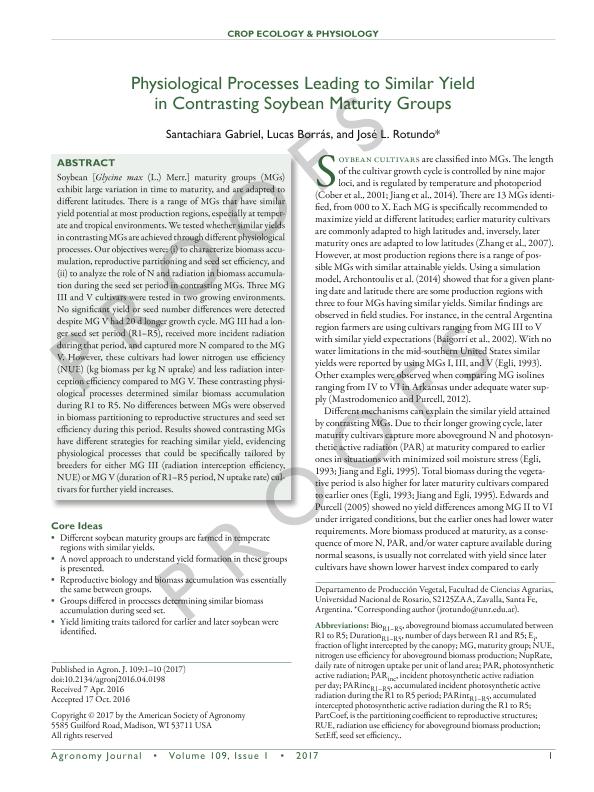Mostrar el registro sencillo del ítem
dc.contributor.author
Santachiara, Gabriel

dc.contributor.author
Borras, Lucas

dc.contributor.author
Rotundo, José Luis

dc.date.available
2018-06-29T12:55:51Z
dc.date.issued
2017-01
dc.identifier.citation
Santachiara, Gabriel; Borras, Lucas; Rotundo, José Luis; Physiological processes leading to similar yield in contrasting soybean maturity groups; American Society of Agronomy; Agronomy Journal; 109; 1; 1-2017; 158-167
dc.identifier.issn
0002-1962
dc.identifier.uri
http://hdl.handle.net/11336/50569
dc.description.abstract
Soybean [Glycine max (L.) Merr.] maturity groups (MGs) exhibit large variation in time to maturity, and are adapted to different latitudes. There is a range of MGs that have similar yield potential at most production regions, especially at temperate and tropical environments. We tested whether similar yields in contrasting MGs are achieved through different physiological processes. Our objectives were: (i) to characterize biomass accumulation, reproductive partitioning and seed set efficiency, and (ii) to analyze the role of N and radiation in biomass accumulation during the seed set period in contrasting MGs. Three MG III and V cultivars were tested in two growing environments. No significant yield or seed number differences were detected despite MG V had 20 d longer growth cycle. MG III had a longer seed set period (R1–R5), received more incident radiation during that period, and captured more N compared to the MG V. However, these cultivars had lower nitrogen use efficiency (NUE) (g biomass per g N uptake) and less radiation interception efficiency compared to MG V. These contrasting physiological processes determined similar biomass accumulation during R1 to R5. No differences between MGs were observed in biomass partitioning to reproductive structures and seed set efficiency during this period. Results showed contrasting MGs have different strategies for reaching similar yield, evidencing physiological processes that could be specifically tailored by breeders for either MG III (radiation interception efficiency, NUE) or MG V (duration of R1–R5 period, N uptake rate) cultivars for further yield increases.
dc.format
application/pdf
dc.language.iso
eng
dc.publisher
American Society of Agronomy

dc.rights
info:eu-repo/semantics/openAccess
dc.rights.uri
https://creativecommons.org/licenses/by-nc-sa/2.5/ar/
dc.subject
Soybean
dc.subject
Maturity Groups
dc.subject
Nitrogen
dc.subject
Radiation
dc.subject.classification
Agricultura

dc.subject.classification
Agricultura, Silvicultura y Pesca

dc.subject.classification
CIENCIAS AGRÍCOLAS

dc.title
Physiological processes leading to similar yield in contrasting soybean maturity groups
dc.type
info:eu-repo/semantics/article
dc.type
info:ar-repo/semantics/artículo
dc.type
info:eu-repo/semantics/publishedVersion
dc.date.updated
2018-06-26T22:33:20Z
dc.journal.volume
109
dc.journal.number
1
dc.journal.pagination
158-167
dc.journal.pais
Estados Unidos

dc.description.fil
Fil: Santachiara, Gabriel. Universidad Nacional de Rosario. Facultad de Ciencias Agrarias. Departamento de Producción Vegetal; Argentina. Consejo Nacional de Investigaciones Científicas y Técnicas; Argentina
dc.description.fil
Fil: Borras, Lucas. Universidad Nacional de Rosario. Facultad de Ciencias Agrarias. Departamento de Producción Vegetal; Argentina. Consejo Nacional de Investigaciones Científicas y Técnicas; Argentina
dc.description.fil
Fil: Rotundo, José Luis. Universidad Nacional de Rosario. Facultad de Ciencias Agrarias. Departamento de Producción Vegetal; Argentina. Consejo Nacional de Investigaciones Científicas y Técnicas; Argentina
dc.journal.title
Agronomy Journal

dc.relation.alternativeid
info:eu-repo/semantics/altIdentifier/doi/http://dx.doi.org/10.2134/agronj2016.04.0198
dc.relation.alternativeid
info:eu-repo/semantics/altIdentifier/url/https://dl.sciencesocieties.org/publications/aj/abstracts/109/1/158
Archivos asociados
